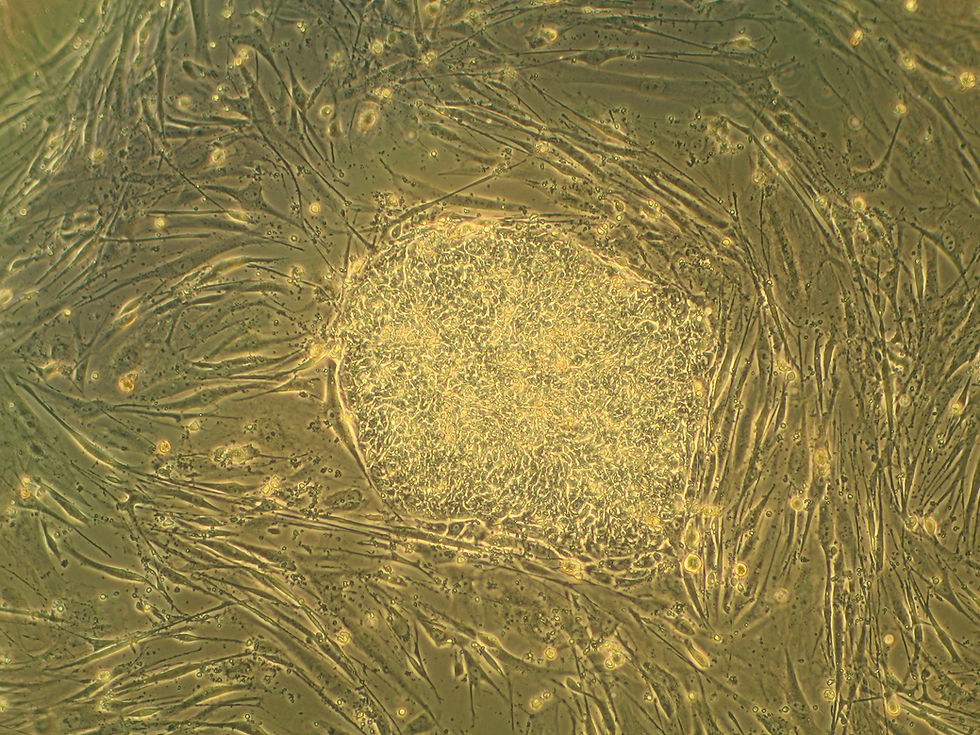The Stem Cell Revolution
- Sidharth Raghavan

- Apr 11, 2020
- 4 min read
Updated: Aug 28, 2021
(A version of this article can also be found on The Grizzly. Link:https://thegrizzlynews.org/790/showcase/the-stem-cell-revolution/)

More than 300 years after Robert Hooke discovered cells, scientists are still trying to understand and apply their knowledge of cells to medical practice. If you’ve been following breakthroughs in science lately, you’ve probably heard of stem cells. But what are stem cells? Stem cells are unique because they have the ability to divide and differentiate into many different types of cells. For example, a baby starts as a single cell, called the embryonic stem cell, which divides repeatedly and eventually gives rise to multiple cell types that make up the various tissues and organs. However, embryonic stem cells are actually one of many kinds of stem cells. Other stem cells include: Adult stem cells, which come from developed tissues and organs, and Induced Pluripotent Stem Cells, which are manipulated to resemble embryonic stem cells.
Scientists believe that stem cells are the key to unlocking the cure for a whole host of devastating illnesses like cancer, diabetes, and heart disease. Adult stem cells from the blood are already being utilized in stem cell transplants for individuals with cancers like leukemia to make new, normal blood cells. Once, one could only dream of using stem cells as a treatment; but now scientists can see the day where stem cells produce an entire organ - even a heart! Today, stem cell therapy is being used to promote the repair of damaged tissue, where scientists grow and manipulate stem cells in a lab to be later injected into a patient with a specific condition. This is also known as regenerative medicine. Stem cells are also already being used in drug testing to detect their toxicity which could aid in solving conditions like autism. Embryonic stem cells are important for the testing of drugs for children because they mimic the cells of a young child. Additionally, stem cells allow scientists to create tissues that mimic human tissues for drug testing, so that they don’t test potentially dangerous drugs on humans. In recent years, stem cell research has exploded, adding many new cures and discoveries to the textbook of medicine. Scientists have created innovative designs, using stem cells, to both help patients and delve deeper into the unknown of what biology has to offer.

In order to make a new heart from one’s own cells, scientists would need a special type of stem cell that resembles the embryonic stem cell but is from an adult. Shinya Yamanaka, a professor at Kyoto University and Nobel Prize recipient, first generated this type of adult stem cell called the induced Pluripotent Stem Cell (iPS cell). The iPS technique allows scientists to take cells from a patient and transform them into the needed cell type while keeping the genetic information of the original cell the same. This is extremely useful because it bypasses the problem of transplant rejection. Typically, when a foreign cell enters the human body, the immune system mounts a violent reaction to destroy the foreign cell. However, if the transplanted cells are generated from one’s own cells, then they will not be rejected.
Stem cell research is fairly new, but scientists have still been able to develop complex tissues in a short amount of time. Yoshiki Sasai, who was the director of the laboratory for Organogenesis and Neurogenesis at the research institute RIKEN, grew one of the most intricate tissues in the human body using stem cells, the retina. Sasai and his team utilized mouse embryonic stem cells and specific proteins to grow the retina in a dish. Growing a retina is cool, but how will it advance medical treatments? Sasai suspected that his methods with mouse embryonic stem cells will also work with iPS cells so that a human retina could be made. These artificial retinas could help researchers in developing drugs and techniques to cure eye diseases

On another front of stem cell research, one group of scientists was making strides in tissue engineering. Robert Langer, a chemical engineer and professor at MIT, is working on developing organs from human embryonic stem cells (hES cells). Langer is using his background in chemical engineering to crack pressing problems in biology by pioneering a new field: tissue engineering. The material that the embryonic stem cells grow on is important because it can control its behavior, so Langer and his team examined many materials before they narrowed them down to just one 3-D synthetic polymer that would best control hES cell behavior. Langer and his team have also developed synthetic skin using stem cells. After scouring through hundreds of polymers, they found one that resembled human skin the best in strength, appearance, and elasticity. Synthetic skin might, at first glance, only seem great for aesthetic purposes however, it’s crucial for skin transplants when people, like firefighters, receive debilitating burns. Langer’s award-winning work isn’t over; he plans to continue working towards his goal of making entire organs for implantation.
The future of stem cell research seems bright and interesting, as new tools and technologies are transforming treatments as fast as we develop them. Especially in the world that we live in today, with viruses and diseases running rampant, stealing people’s lives, stem cells will prove to be an irreplaceable tool in aiding scientists and the people of this world whether you are ready for them or not. Some scientists even believe that stem cells could help in treating COVID-19. The stem cell revolution is here, helping push the boundaries of human knowledge, and forging a new hope to cure some of the most deadly diseases in the world.
Thanks for reading!




Comments